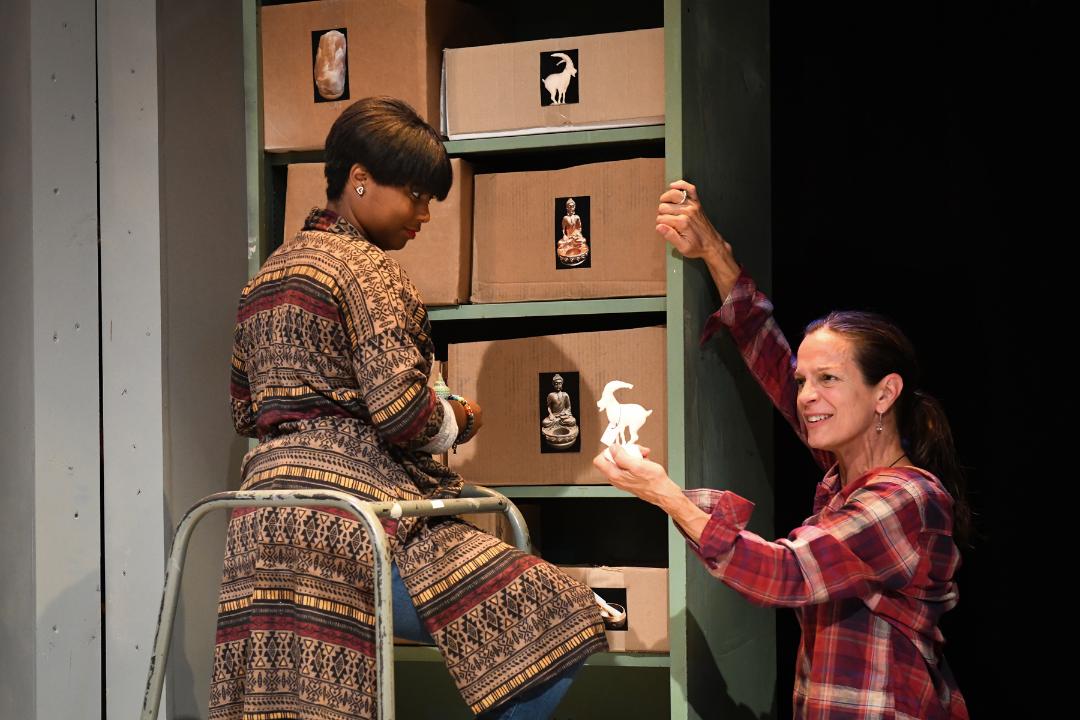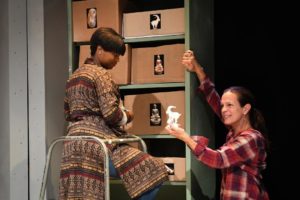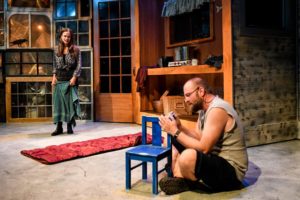
 [rating=5]Transformative and infinitely entertaining, “Be Here Now” is a witty comedy, romance, and tragedy rolled into One. It is Deborah Zoe Laufer’s brilliantly perceptive take on the meaning of life and happiness in today’s world.
[rating=5]Transformative and infinitely entertaining, “Be Here Now” is a witty comedy, romance, and tragedy rolled into One. It is Deborah Zoe Laufer’s brilliantly perceptive take on the meaning of life and happiness in today’s world.
Is happiness a choice or something that happens to you? How much is our brain wired for happiness or not? Is meditation or prayer one route for happiness or the only route, if at all? Is it enough to wish to be happy, or do we have to work at it? Are we are supposed to be happy?
The phrase “Be Here Now” is the admonition of the yogic masters to be fully aware of the present at each moment of our lives. The story is set Cooperstown, New York, but the larger story is set in the various planes of existence that human beings touch upon. To gain a better appreciation of the play, it is important to demonstrate how the storyline is grounded in the philosophies of yoga and Buddhism.
So together, let’s shift our collective awareness. Ah! Or should I say Om?
In the opening scene, the audience is brought into the meditative state via a guided meditation. “Focus on the breath” we are told. The darkness fades up to reveal a scene at a yoga studio. The three female actors on stage represent three extreme characters, each corresponding to one of three types of motivations that all human beings have, according to the Buddha.
Luanne (Demetra Dee) represents the kama tanha, the desire for sensory and sexual gratification, novel stimuli, and pleasure. Content to live her life focusing on hedonism, she delights in taking photos of her ample chest using her cell phone in order to send them to her boyfriend.
Patty (Deanna Reed-Foster) is the personification of bhava tanha, the desire for survival or continued existence. She focuses on working her mundane job that provides her with an income that she needs to live on.
Bari (Rebecca Jordan) is an atheist and a nihilist. She represents the vibhava tanha, the desire for annihilation and non-existence. For her, there is no happiness in life. She is a very cerebral person who believes that happiness is a ruse to make people satisfied with their lot. She is living a life without love and sees no light or beauty in this world. She thus perceives the absence of everything and dwells on misery.
The desires that motivate each of these three characters are directed towards ending their suffering on earth; that is, ridding themselves of stress, pain, sorrow, and distress. However, according to the Buddha, acting on these desires is futile, illusory, and unfulfilling. A more permanent solution to the human condition is to transcend these desires through meditation, with the aim of attaining enlightenment and spiritual union with the Infinite Mind. Whether and how this can be accomplished is an overriding theme throughout the play.
All three women work together at a fulfillment center, where they fulfill orders by pulling stock, packing boxes, and sending out packages in the mail. The center is representative of dharma, or the nature of reality. Like a double-sided coin, there is the commercial, or material, side of fulfillment: in this case, it is representative of a workplace where people lead their everyday lives. However, the obverse side is spiritual fulfillment: the seeking and attaining of something greater, something unknown that is beyond ordinary existence.
All day, the women pack statues: clay and resin representations of Buddha and various gods of Eastern religions. These goods (or gods) would, to some, be considered idols that have no feeling, spirit, or power associated them—that is, unless one changes one’s perspective. The same material objects looked upon in a spiritual light can simultaneously become a tool for evoking deep feeling and harmony with the Universe. In this way, the objects become beautiful and then sacred.
Since Bari sees no beauty in the people and the objects around her, Patty insists that Bari needs to meet Mike (Joseph Wiens), who is a tinkerer and an artist. He’s one of the few people in town that she does not already know, and Patty believes that he might help change her perspective on life. But Bari is reluctant to go out on a blind date.
She meets Mike anyway, if anything to tell him that she doesn’t want to go through with her date with him. After a series of missteps, the two actually talk to each other in a meaningful way. Mike has suffered through a number of horrible tragedies in his own life, including the loss of his family. Though physically unscathed, he is deeply wounded psychologically and cannot get past his immeasurable guilt and grief.
At the time of their date, Mike finds a stroller and a woven basket in the trash, and he seems more interested in these objects than he is in her. Basically, he repurposes garbage. Considered a genius with his inspiration for building functional dwellings in a creative, artistic fashion, Mike’s deconstruction of material items thus becomes the source of creative reconstruction. Garbage is not really garbage. It is a commodity to be recycled. Out of death comes rebirth, a fundamental theme of reincarnation in Buddhism. As Mike reconfigures mundane items, he gives them new life: a material thing becomes a spiritual thing. Mike claims to have learned this lesson from his pet crow, who had been wounded some time ago by some boys who had shot at it. With the crow as his only companion, Mike has studied over the years how the bird appreciates beauty in small things and in objects that nobody else has a use for: a pile of sticks, a shiny object, and bits and pieces that others discard. 
Being wounded, the crow cannot be free to fly away and move on with its life, but neither can Mike or Bari, who are each broken in their own way. It takes a grand mal seizure (or actually a series of them) for Bari to transcend rationality and comprehend the mystical underpinnings of the universe. Her horrific migraine headaches are followed by seeing vivid colors; then she notices things that she had previously ignored. Her senses suddenly work at a higher level, and she is at bliss. Her mystical experiences create a sudden personality shift, and now she believes in miracles. From being a displeased, despondent nihilist and existentialist, she shifts her perspective entirely and becomes engaged and interested in this world.
Now, back to the Buddhist angle: It is no coincidence that this is a four-character play. Scholars may differ, but it is often taught that there are four types of samadhi, the state of perfect union between the soul and the universe in the form of attaining enlightenment. The four paths to achieve this type of unification of mind typically occur in accordance with a person’s nature and level of consciousness.
Luanne reaches samadhi by being “in the moment” at the yoga studio. Meditation must be guided for her. Samadhi is tentative and fleeting. Patty contemplates an established religion, in her case Christianity, as described by her focus on Easter, simultaneously death and rebirth as well as salvation. It is a tried-and-true pathway for working to find God. For her, samadhi is in the world of action, the seeking of perfection in her daily tasks. Mike achieves samadhi via aesthetics. His tasks are creative, an intermediary plane between this world and the unseen one behind it. Being called a genius means validation for himself and his craft from other human beings. But Bari, in reaching the highest form of mysticism, does not require such validation. It doesn’t matter whether others believe her story or validate her experience. She is the only one of the four who has achieved a one-of-a-kind transcendence, that is, merging with God (or the One, or the Infinite, or the Universe, or the Higher Power) in its purist form.
Bari can see “one step below” her ecstatic state and can thus comprehend the beauty and aesthetics that Mike creates. But Mike cannot see “one step above” his own level of consciousness to understand Bari’s mystical reach and realize how much she craves the perfect joy she feels.
For Mike, who understands the meaning of terrible loss first-hand, what is most important in the last analysis is life itself. Therefore, whether he (or any of the others) understands the meaning or mystery behind it is secondary. The most important thing is to remain alive and actively preserve and protect those souls who are dear to you.
 Perhaps the best summary of this play is in the woven rug that hangs in the background. The audience sees the finished side; yet it is the unfinished side (that we cannot see) that exposes all the work that went into it. The rug is representative of the reality we commonly see and the reality that underlies it, visible only to those who have peered into The Other Side. Without the one can we truly have the other? Is the finished side, or the beautiful side, the happy side? Or does our happiness lie in understanding the underside: the true design and execution and how all of the strings attach?
Perhaps the best summary of this play is in the woven rug that hangs in the background. The audience sees the finished side; yet it is the unfinished side (that we cannot see) that exposes all the work that went into it. The rug is representative of the reality we commonly see and the reality that underlies it, visible only to those who have peered into The Other Side. Without the one can we truly have the other? Is the finished side, or the beautiful side, the happy side? Or does our happiness lie in understanding the underside: the true design and execution and how all of the strings attach?
Beautifully directed by Sandy Shinner, “Be Here Now” features impressive acting, sharp dialogue, and a fine sense of pacing. Laufer’s highly polished, extraordinarily well-written script is in the hands of a master.
Now let’s resume our guided meditation: “Dear reader, bring yourself back into your body. Wiggle your fingers and toes and gently move your arms, legs, shoulders, and neck. Bring your breathing back to normal and start to become aware of your surroundings. When you are ready, open your eyes.”
Don’t meditate any longer. It is time to see this production of “Be Here Now” by the Shattered Globe Theatre Company. It is sublime yet funny at the same time.
“Be Here Now” is playing through October 19, 2019 at Theater Wit, 1229 W. Belmont Avenue, in Chicago.
The performance schedule is as follows:
 Thursdays, Fridays, and Saturdays – 8:00 p.m.
Thursdays, Fridays, and Saturdays – 8:00 p.m.
Sundays – 3:00 p.m.
There will be an an added performance on Saturday, October 19 at 3:00 p.m.
Shattered Globe Theatre will be hosting post-show discussions immediately following 3:00 p.m. performances on Sundays.
Tickets – $42.
Seniors – $35.
Under 30 years old – $25
Student rush tickets available on day of performance – $15
Industry tickets – $15, Fridays only, with code “INDUSTRY”
There will be a touch tour/audio description performance on Friday, October 4. 6:30 p.m. – audio touch tour, 8:00 p.m. performance with audio description. $20 tickets available with code “ACCESS.”
Single tickets are currently available at www.shatteredglobe.org, in person at the Theater Wit Box Office, or by calling (773) 975-8150. Group discounts are currently available by contacting groupsales@shatteredglobe.org
To see what others are saying, visit www.theatreinchicago.com, go to Review Round-Up and click at “Be Here Now”.






More Stories
“The S Paradox” reviewed by Julia W. Rath
“A Year With Frog and Toad”
” Monsieur Chopin” a play with music